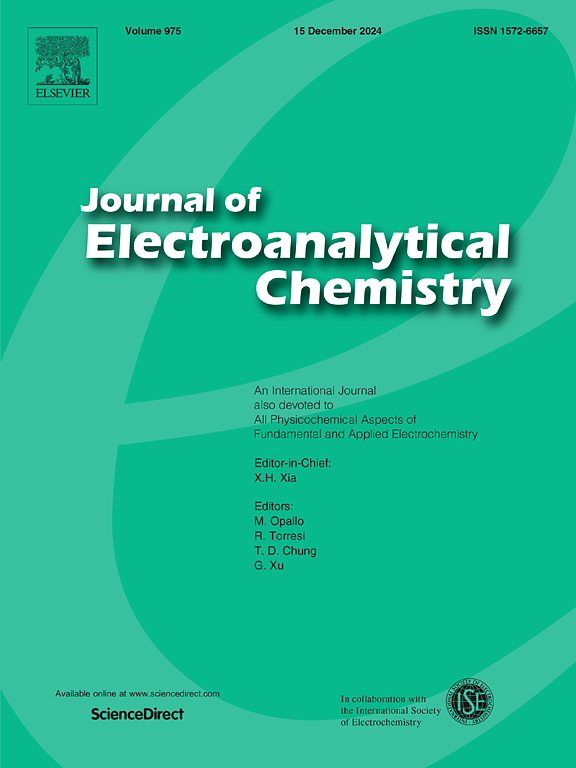Multi-effect enhanced photocathodic protection performance of 304 SS for atom-shared Bi/BiVO4/Bi2S3 photoanode based on decahedral BiVO4
IF 4.1
3区 化学
Q1 CHEMISTRY, ANALYTICAL
引用次数: 0
Abstract
The easily charge recombination and low electron transfer efficiency have limited the enhancement of photocathodic protection (PCP) performance of BiVO4. In this study, Bi atom-shared Bi/BiVO4/Bi2S3 heterojunction with decahedral BiVO4 has been prepared by hydrothermal method and then mixed with PVDF to synthesize a photocathodic protection coating on 304 stainless steels (304 SS). Both the effect of morphology and the atom-shared Bi/BiVO4/Bi2S3 heterojunction on microstructure and PCP performance of BiVO4 were analyzed. Results indicate decahedral BiVO4 has obtained higher PCP performance than normal BiVO4, because the electrons and holes respectively accumulate at the (010) and (110) faces in decahedral BiVO4 to promote e−/h+ pairs' separation. Then PCP performance of 304 SS has further enhanced for Bi atom-shared Bi/BiVO4/Bi2S3 photoanode, with the significantly increased photocurrent density of 160 μA cm2 and the more negative open circuit potential of −0.85 V vs Ag/AgCl. After comparing between Bi-shared Bi/BiVO4/Bi2S3 and Bi/BiVO4@Bi2S3 without sharing atom, we found that the best PCP performance for Bi/BiVO4/Bi2S3 were resulted from three effects: the atomic-level contacts between BiVO4 and Bi2S3 in Bi atom-shared heterojunction to enhance electron transfer efficiency, decahedral BiVO4 to separate carriers and localized surface plasmon resonance (LSPR) effect of Bi to generate more thermalelectrons to transfer to 304 SS. This research offers a strategy to improve PCP capability of BiVO4 through multi-effect of tuning the morphology and building atom-shared heterojunction.

基于十面体BiVO4的原子共享BiVO4/Bi2S3光阳极304 SS的多效应增强光阴极保护性能
易电荷重组和低电子转移效率限制了BiVO4光电阴极保护性能的提高。本研究采用水热法制备了Bi原子共享Bi/BiVO4/Bi2S3与十面体BiVO4异质结,然后与PVDF混合,在304不锈钢(304 SS)表面合成了光电阴极保护涂层。分析了形貌和原子共享Bi/BiVO4/Bi2S3异质结对BiVO4微观结构和PCP性能的影响。结果表明,十面体BiVO4比普通BiVO4具有更高的PCP性能,这是由于十面体BiVO4的电子和空穴分别聚集在(010)和(110)面,促进了e−/h+对的分离。在Bi原子共享的Bi/BiVO4/Bi2S3光阳极中,304 SS的PCP性能得到了进一步提高,光电流密度显著提高到160 μA cm2,开路电位更负,为−0.85 V vs Ag/AgCl。通过对Bi/BiVO4/Bi2S3与未共享原子的Bi/BiVO4@Bi2S3的比较,我们发现Bi/BiVO4/Bi2S3的最佳PCP性能是由三个因素造成的:BiVO4与Bi2S3在Bi原子共享异质结中的原子级接触提高电子转移效率,BiVO4的十面体分离载流子,以及Bi的局域表面等离子体共振(LSPR)效应产生更多的热电子转移到304 SS。本研究提出了通过调整形貌和构建原子共享异质结的多效应来提高BiVO4的PCP能力的策略。
本文章由计算机程序翻译,如有差异,请以英文原文为准。
求助全文
约1分钟内获得全文
求助全文
来源期刊
CiteScore
7.80
自引率
6.70%
发文量
912
审稿时长
2.4 months
期刊介绍:
The Journal of Electroanalytical Chemistry is the foremost international journal devoted to the interdisciplinary subject of electrochemistry in all its aspects, theoretical as well as applied.
Electrochemistry is a wide ranging area that is in a state of continuous evolution. Rather than compiling a long list of topics covered by the Journal, the editors would like to draw particular attention to the key issues of novelty, topicality and quality. Papers should present new and interesting electrochemical science in a way that is accessible to the reader. The presentation and discussion should be at a level that is consistent with the international status of the Journal. Reports describing the application of well-established techniques to problems that are essentially technical will not be accepted. Similarly, papers that report observations but fail to provide adequate interpretation will be rejected by the Editors. Papers dealing with technical electrochemistry should be submitted to other specialist journals unless the authors can show that their work provides substantially new insights into electrochemical processes.

 求助内容:
求助内容: 应助结果提醒方式:
应助结果提醒方式:


